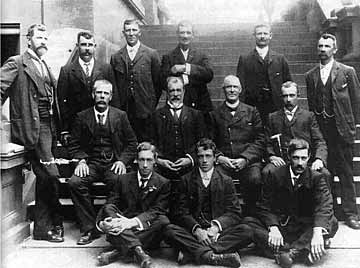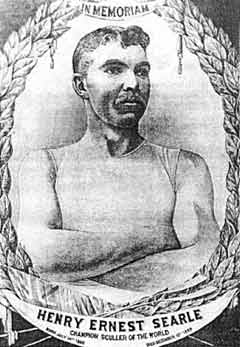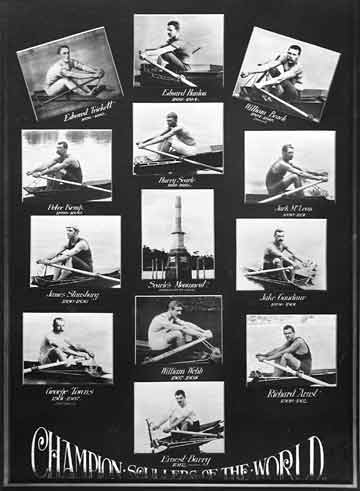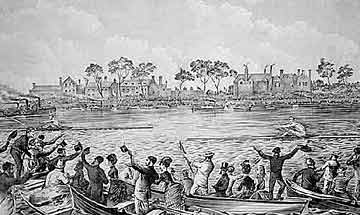World Professional Sculling Championships
- Introduction
- Record of Racing—table summarising racing results from 1831 to 1958
- Brief History of Australians in World Professional Sculling
- 1926 Rules Governing World Professional Sculling
- 1863 Chambers (GBR)
def Green (AUS) - 1876 Trickett (AUS)
def Sadler (GBR) - 1877 Trickett (AUS)
def Rush (AUS) - 1879 Trickett (AUS)
def Laycock (AUS) - 1880 Hanlan (CAN)
def Trickett (AUS) - 1881 Hanlan (CAN)
def Laycock (AUS) - 1882 Hanlan (CAN)
def Trickett (AUS) - 1884 Hanlan (CAN)
def Laycock (AUS) - 1884 Beach (AUS)
def Hanlan (CAN) - 1885 Beach (AUS)
def Hanlan (CAN) - 1886 Beach (AUS)
def Ross (UK) - 1887 Beach retires & forfeits to Kemp (AUS)
- 1888 Kemp (AUS)
def Hanlan (CAN)—twice - 1888 Searle (AUS)
def Kemp (AUS) - 1889 Searle (AUS)
def O'Connor (CAN) - 1890 McLean (AUS)
def Kemp (AUS) - 1891 Stanbury (AUS)
def McLean (AUS) - 1896 Stanbury (AUS)
def Harding (GBR) - 1901 Towns (AUS)
def Gaudaur (CAN) - 1904 Towns (AUS)
def Tressider (AUS) - 1905 Stanbury (AUS)
def Towns (AUS) - 1906 Towns (AUS)
def Stanbury (AUS) - 1908 Arnst (NZL)
def Webb (NZL) - 1910 Arnst (NZL)
def Barry (GBR) - 1911 Arnst (NZL)
def Pearce (AUS) - 1912 Barry (GBR)
def Arnst (NZL) - 1913 Barry (GBR)
def Pearce (AUS) - 1914 Barry (GBR)
def Paddon (AUS) - 1919 Felton (AUS)
def Barry (GBR) - 1920 Barry (GBR)
def Felton (AUS) - 1921 Arnst (NZL) regains title by forfeit from Barry (GBR) who retires
- 1921 Arnst (NZL)
def Hannan (NZL) - 1922 Hadfield (NZL)
def Arnst (NZL) - 1922 Paddon (AUS)
def Hadfield (NZL) - 1923 Paddon (AUS)
def Hadfield (NZL) - 1925 Goodsell (AUS)
def McDevitt - 1925 Goodsell (AUS)
def Hannan (NZL) - 1925 Goodsell (AUS)
def Paddon (AUS) - 1926 Goodsell (AUS)
def Saul (AUS) - 1927 Goodsell (AUS)
def Barry (GBR) - 1927 Barry (GBR)
def Goodsell (AUS) - 1932 Phelps (GBR)
def Goodsell (AUS) - 1933 Pearce (AUS)
def Phelps (GBR) - 1934 Pearce (AUS)
def Miller (USA) - 1938 Pearce
def Paddon (AUS) - 1948 Paddon (AUS)
def Fisher (AUS) - 1949 Cook (AUS)
def Paddon (AUS) - 1950 Paddon (AUS)
def Cook (AUS) - 1952 Saul (AUS)
def Paddon (AUS) - 1952 Paddon (AUS)
def Saul (AUS) - 1953 Fischer (AUS)
def Paddon (AUS)
Brief History of Australians in World Professional Sculling
Professional sculling grew from its base in England where it was a popular sport in the mid 1800s. Scott Bennett in his book The Clarence Comet states that the sport went into decline in England during the 1870's largely because of shady practices and also because it just could not match the money available to sponsor races in Australia. The money for the sport was either in Australia or in North America at that time. Hence the championship was held largely by Australians, Canadians and Americans. Also, Hylton Cleaver in his book A History of Rowing (Herbert Jenkins Ltd 1957) mentioned that the decline in professional sculling in England was also mirrored by a decline in British amateur rowing.
Professional sculling was the biggest sport in Australia for most of the 60 years prior to World War I, particularly up to about 1907. Due to the need for water transport and hence professional watermen, the sport was centred in Sydney and the Northern Rivers of New South Wales. Rowing in general was also of great interest as it was reported that the Victorian Football League always made sure that football matches were not played on the same days as regattas because the regattas would always draw the crowds.

Australian Scullers at a Lord Mayoral reception in 1903
Back row l-r: Elias Laycock, James Stanbury, Harry Pearce Jnr, Harry Pearce, Chris
Nielson, Peter Kemp
Centre row l-r: William Beach, Michael Rush, Edward Trickett, George Towns
Front row l-r: Charles Towns, C A Messenger, A Towns
The peak of this enthusiasm was in the period up to about 1907. A B "Banjo" Patterson wrote:
"On the death of Searle, the championship was claimed by Maclean and Stanbury of Australia and O'Connor of America; but after the renaissance came the decline; apart from the general decline to bet on anything that could speak, the expenses killed the business. The only gate-money that could be got was a percentage from the steamers, and it cost five hundred pounds to boat and train a man properly in a match for two hundred pounds a side. So the glamour of professional rowing passed away from the old river, a few enthusiasts only keeping the sport alive."

In Memoriam
Henry Ernest Searle
Champion Sculler of the World
An example of the decline in interest was that Jim Stanbury was not challenged from 1892 to 1896 when he went to England to defend the title.
Professional sculling drew huge crowds which would stop whole cities. The race between Edward Harlan (CAN) and Bill Beach (AUS) in 1884 drew crowds of over 100,000. This equated to half of the Sydney population at that time. It is reported that special trains were put on to get the crowds to the event from as far away as Goulburn and Bathurst.
When the great Henry Searle died in 1889 even Melbourne, where professional sculling did not exist to any material degree, drew a crowd of 40,000 to witness the cortege pass. The crowds in his home town Sydney were estimated at 170,000. Rowing was the major sport of those times.
The sport drew huge cash purses, probably higher than the equivalent prizes at grand slam tennis matches of today. Betting was also huge, and betting between competitors was the standard procedure. A challenge to become World Champion was accompanied by a side bet between the competitors, usually in the order of £500-1,000.
When Trickett arrived in London for his challenge, he carried both funds for his bet with Sadler and also £10,000 from a Sydney betting syndicate. He placed the money on himself at odds of mostly 2:1.
When the cable of his victory reached Sydney at 4am, the cheers of syndicate members awoke all within several blocks. To put the figures in perspective, £1,000 would equate to roughly 10 years wages without tax.
Money enabled the sport to survive and for scullers to be full time professional sportsmen. No sportsman would have the resources to train full time and also put up the money to secure a challenge. This required backing from syndicates of interested people who in essence were betting syndicates created around each sculler. They would of course take the major part of the purse.

Champions of the World Poster
The sport had similar effects on regional centres. The Grafton Rowing Club history reports:
"Regattas drew huge crowds and were such special events that holidays were sometimes declared to allow spectators to attend. In 1880, a holiday for businesses and schools was declared in Grafton to allow people to travel downstream to a regatta held at Maclean, with Michael Rush taking on all comers in the main event."
John Lang notes in his book The Victorian Oarsman in 1919:
"During the thirty-eight years in which the title has been rowed for pre WW1 (1876-1914) there have been forty-five contests, of which Australia has won thirty-two: (Beach 7; Kemp, Stanbury and Arnst, each 5; (Note - Arnst learned his rowing here, and has always raced as an Australian, not for New Zealand.) G. Towns 4; Trickett 3; Searle 2; McLean 1.
"Hanlan and Gardener (Canada) won 7 between them; England (Barry) 4; New Zealand (Webb) 2.
"Sixteen Australians have competed in other countries for the Championship of the World, or Championship of England, and all won—and some won and lost. A few, very few; had to be content with the honour of having tried, including H. Pearce, H. W. Pearce, J. Paddon, and W: Fogwell."
Pre 1876
Professional sculling and rowing in Australia were well established with the first professional rowing race reported as being in 1805. These were challenge races between Sydney watermen and crews from visiting ships. The Collector of Customs, Captain John Piper, had a good crew and challenged crews from three merchant vessels for the huge stake of 200 guineas.

Scullers Racing
Regattas commenced by 1827 but professional sculling in the form which created World Champions did not commence until about 1850. A strong field of great scullers was created including Dick Green, John McGrath, Michael Rush, Elias Laycock and Edward Trickett.
One of the issues of professional sculling was how to govern disputes and the race itself. For example Jim Paddon claimed the World Title from Alf Felton in 1920 as he challenged him first after Felton won the title. Felton replied that irregardless of the rules he had promised the first challenge to Barry. Actions were stronger than words and the next race was against Barry.

